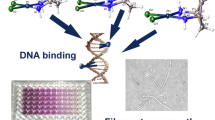Abstract
Purpose: The authors have previously reported that trans-bis(n-valerato)(1R,2R-cyclohexanediamine) (oxalato)platinum(IV) (C5-OHP), an oxaliplatin derivative, is an orally active antitumor agent in an intraperitoneal (i.p.) L1210 murine leukemia model. In this study, several oxaliplatin derivatives of the general formula trans-(carboxylato)chloro(1R,2R-cyclohexanediamine)(oxalato)platinum(IV) were synthesized in order to find new derivatives with greater oral activity than C5-OHP in a clinically predictive tumor model. In the formula, the carboxylate and chloride ligands are situated in axial positions. Methods: Four complexes with the axial carboxylate ligands n-butyrate, n-valerate, n-caproate or n-heptanoate were synthesized and designated C4-OHP-Cl, C5-OHP-Cl, C6-OHP-Cl and C7- OHP-Cl, respectively. The oral antitumor activity of the complexes was evaluated against the murine reticulosarcoma M5076 implanted subcutaneoulsy (s.c.) in to male BDF1 mice. The complexes were administered orally daily for 5 days in two cycles initiated on days 5 and 12 postimplantation. The physicochemical properties were examined by measuring the concentrations of the complexes in test solutions at intervals by HPLC. The pharmacokinetic behaviors of C5-OHP-Cl, C6-OHP-Cl and C5-OHP following a single oral administration were studied in non-tumor-bearing male BDF1 mice. Results: Of the complexes synthesized in this study, C5-OHP-Cl, which exhibited high activity in the i.p. L1210 model, was found to be orally active in the s.c. M5076 model while C5-OHP was not. The in vitro reduction of the complexes by ascorbate was much more rapid than that of C5-OHP, while the complexes were more stable than C5-OHP in HCl-acidic and alkaline solutions. Pharmacokinetic study showed that Cmax and AUC0–24h values of plasma total and filterable platinum of C5-OHP-Cl were four to six times greater than those of C5-OHP, indicating that C5-OHP-Cl was absorbed more than C5-OHP. Conclusion: C5-OHP-Cl was found to be a superior l-OHP derivative C5-OHP, exhibiting significant oral antitumor activity in the s.c. M5076 model. The enhanced activity of C5-OHP-Cl was considered to be due in part to increased susceptibility to reduction and increased gastrointestinal absorption. C5-OHP-Cl is a suitable candidate for further study as an oral cancer chemotherapy agent.
Similar content being viewed by others
Author information
Authors and Affiliations
Additional information
Received: 22 January 1998 / Accepted: 20 May 1998
Rights and permissions
About this article
Cite this article
Kizu, R., Nakanishi, T., Hayakawa, K. et al. A new orally active antitumor 1R,2R-cyclohexanediamine-platinum(IV) complex: trans-(n-valerato)chloro(1R,2R-cyclohexanediamine) (oxalato)platinum(IV). Cancer Chemother Pharmacol 43, 97–105 (1999). https://doi.org/10.1007/s002800050869
Issue Date:
DOI: https://doi.org/10.1007/s002800050869




